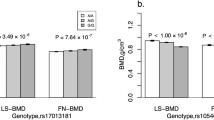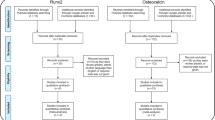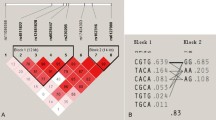Abstract
Summary
A novel polymorphism (+1871A>G) in the 3′ flanking region and haplotypes were significantly associated with reduced osteoporosis risk and enhanced bone mineral density (BMD). These results suggest that TWIST1 may be a useful genetic marker for osteoporosis. Our results provide preliminary evidence supporting an association of TWIST1 with osteoporosis in postmenopausal women.
Introduction
TWIST1, a basic helix–loop–helix (bHLH) transcription factor, has been implicated in cell lineage determination and differentiation.
Methods
To address the genetic variations in the TWIST1 gene associated with osteoporosis, we investigated the potential involvement of three TWIST1 single-nucleotide polymorphisms (SNPs) in osteoporosis in 729 postmenopausal women. BMD was measured using dual-energy X-ray absorptiometry.
Results
A novel polymorphism in the 3′ flanking region (+1871A>G) was significantly associated with osteoporosis risk (p = 0.007–0.008) and also in multiple comparison (p = 0.02). Consistent with these results, haplotype analysis showed that Block1_ht2 had protective effects in the dominant and additive model (p = 0.006–0.007). Specifically, the +1871A>G polymorphism was overdominantly associated with higher BMD values of the femoral neck (p = 0.039).
Conclusion
These results suggest that TWIST1 may be a useful genetic marker for osteoporosis and may have a role on bone metabolism in humans. Our results provide preliminary evidence supporting an association of TWIST1 with osteoporosis in postmenopausal women.

Similar content being viewed by others
References
Hwang JY, Lee JY, Park MH, Kim KS, Kim KK, Ryu HJ, Lee JK, Han BG, Kim JW, Oh B, Kimm K, Park BL, Shin HD, Kim TH, Hong JM, Park EK, Kim DJ, Koh JM, Kim GS, Kim SY (2006) Association of PLXNA2 polymorphisms with vertebral fracture risk and bone mineral density in postmenopausal Korean population. Osteoporos Int 17:1592–1601
Arden NK, Spector TD (1997) Genetic influences on muscle strength, lean body mass, and bone mineral density: a twin study. J Bone Miner Res 12:2076–2081
Videman T, Levalahti E, Battie MC, Simonen R, Vanninen E, Kaprio J (2007) Heritability of BMD of femoral neck and lumbar spine: a multivariate twin study of Finnish men. J Bone Miner Res 22:1455–1462
Ng MY, Sham PC, Paterson AD, Chan V, Kung AW (2006) Effect of environmental factors and gender on the heritability of bone mineral density and bone size. Ann Hum Genet 70:428–438
Havill LM, Mahaney MC, LB T, Specker BL (2007) Effects of genes, sex, age, and activity on BMC, bone size, and areal and volumetric BMD. J Bone Miner Res 22:737–746
Hamamori Y, Wu HY, Sartorelli V, Kedes L (1997) The basic domain of myogenic basic helix–loop–helix (bHLH) proteins is the novel target for direct inhibition by another bHLH protein, Twist. Mol Cell Biol 17:6563–6573
Thomas T, Yamagishi H, Overbeek PA, Olson EN, Srivastava D (1998) The bHLH factors, dHAND and eHAND, specify pulmonary and systemic cardiac ventricles independent of left-right sidedness. Dev Biol 196:228–236
Lister JA, Baron MH (1998) Induction of basic helix–loop–helix protein-containing complexes during erythroid differentiation. Gene Expr 7:25–38
Anderson DJ, Groves A, Lo L, Ma Q, Rao M, Shah NM, Sommer L (1997) Cell lineage determination and the control of neuronal identity in the neural crest. Cold Spring Harb Symp Quant Biol 62:493–504
Verzi MP, Anderson JP, Dodou E, Kelly KK, Greene SB, North BJ, Cripps RM, Black BL (2002) N-twist, an evolutionarily conserved bHLH protein expressed in the developing CNS, functions as a transcriptional inhibitor. Dev Biol 249:174–190
Reinhold MI, Kapadia RM, Liao Z, Naski MC (2006) The Wnt-inducible transcription factor Twist1 inhibits chondrogenesis. J Biol Chem 281:1381–1388
Bialek P, Kern B, Yang X, Schrock M, Sosic D, Hong N, Wu H, Yu K, Ornitz DM, Olson EN, Justice MJ, Karsenty G (2004) A twist code determines the onset of osteoblast differentiation. Dev Cell 6:423–435
Lee MS, Lowe GN, Strong DD, Wergedal JE, Glackin CA (1999) TWIST, a basic helix–loop–helix transcription factor, can regulate the human osteogenic lineage. J Cell Biochem 75:566–577
Laursen KB, Mielke E, Iannaccone P, Fuchtbauer EM (2007) Mechanism of transcriptional activation by the proto-oncogene Twist1. J Biol Chem 282:34623–34633
Mironchik Y, Winnard PT Jr, Vesuna F, Kato Y, Wildes F, Pathak AP, Kominsky S, Artemov D, Bhujwalla Z, Van Diest P, Burger H, Glackin C, Raman V (2005) Twist overexpression induces in vivo angiogenesis and correlates with chromosomal instability in breast cancer. Cancer Res 65:10801–10809
Vesuna F, van Diest P, Chen JH, Raman V (2008) Twist is a transcriptional repressor of E-cadherin gene expression in breast cancer. Biochem Biophys Res Commun 367:235–241
Kwok WK, Ling MT, Lee TW, Lau TC, Zhou C, Zhang X, Chua CW, Chan KW, Chan FL, Glackin C, Wong YC, Wang X (2005) Up-regulation of TWIST in prostate cancer and its implication as a therapeutic target. Cancer Res 65:5153–5162
Yan-Qi Z, Xue-Yan G, Shuang H, Yu C, Fu-Lin G, Fei-Hu B, Shi-Ren S, Xu-Feng W, Jie D, Dai-Ming F (2007) Expression and significance of TWIST basic helix–loop–helix protein over-expression in gastric cancer. Pathology 39:470–475
Yousfi M, Lasmoles F, El Ghouzzi V, Marie PJ (2002) Twist haploinsufficiency in Saethre–Chotzen syndrome induces calvarial osteoblast apoptosis due to increased TNFalpha expression and caspase-2 activation. Hum Mol Genet 11:359–369
Howard TD, Paznekas WA, Green ED, Chiang LC, Ma N, Ortiz de Luna RI, Garcia Delgado C, Gonzalez-Ramos M, Kline AD, Jabs EW (1997) Mutations in TWIST, a basic helix–loop–helix transcription factor, in Saethre–Chotzen syndrome. Nat Genet 15:36–41
Guenou H, Kaabeche K, Mee SL, Marie PJ (2005) A role for fibroblast growth factor receptor-2 in the altered osteoblast phenotype induced by Twist haploinsufficiency in the Saethre–Chotzen syndrome. Hum Mol Genet 14:1429–1439
Yousfi M, Lasmoles F, Lomri A, Delannoy P, Marie PJ (2001) Increased bone formation and decreased osteocalcin expression induced by reduced Twist dosage in Saethre–Chotzen syndrome. J Clin Invest 107:1153–1161
Komori T (2006) Regulation of osteoblast differentiation by transcription factors. J Cell Biochem 99:1233–1239
Kronenberg HM (2004) Twist genes regulate Runx2 and bone formation. Dev Cell 6:317–318
Rice DP, Aberg T, Chan Y, Tang Z, Kettunen PJ, Pakarinen L, Maxson RE, Thesleff I (2000) Integration of FGF and TWIST in calvarial bone and suture development. Development 127:1845–1855
Oldroyd B, Smith AH, Truscott JG (2003) Cross-calibration of GE/Lunar pencil and fan-beam dual energy densitometers—bone mineral density and body composition studies. Eur J Clin Nutr 57:977–987
Gordon D, Abajian C, Green P (1998) Consed: a graphical tool for sequence finishing. Genome Res 8:195–202
Ewing B, Hillier L, Wendl MC, Green P (1998) Base-calling of automated sequencer traces using phred. I. Accuracy assessment. Genome Res 8:175–185
Oliphant A, Barker DL, Stuelpnagel JR, Chee MS (2002) BeadArray technology: enabling an accurate, cost-effective approach to high-throughput genotyping. BioTechniques Suppl:56–58, 60–51
Purcell S, Cherny SS, Sham PC (2003) Genetic Power Calculator: design of linkage and association genetic mapping studies of complex traits. Bioinformatics 19:149–150
Gauderman WJ (2002) Sample size requirements for association studies of gene–gene interaction. Am J Epidemiol 155:478–484
Deng HW, Chen WM, Recker S, Stegman MR, Li JL, Davies KM, Zhou Y, Deng H, Heaney R, Recker RR (2000) Genetic determination of Colles' fracture and differential bone mass in women with and without Colles' fracture. J Bone Miner Res 15:1243–1252
MacGregor A, Snieder H, Spector TD (2000) Genetic factors and osteoporotic fractures in elderly people. Twin data support genetic contribution to risk of fracture. BMJ 320:1669–1670 author reply 1670–1661
Castanon I, Baylies MK (2002) A Twist in fate: evolutionary comparison of Twist structure and function. Gene 287:11–22
Lee MS, Lowe G, Flanagan S, Kuchler K, Glackin CA (2000) Human Dermo-1 has attributes similar to twist in early bone development. Bone 27:591–602
Jabs EW (2001) A TWIST in the fate of human osteoblasts identifies signaling molecules involved in skull development. J Clin Invest 107:1075–1077
Yuan HY, Chiou JJ, Tseng WH, Liu CH, Liu CK, Lin YJ, Wang HH, Yao A, Chen YT, Hsu CN (2006) FASTSNP: an always up-to-date and extendable service for SNP function analysis and prioritization. Nucleic Acids Res 34:W635–641
Landgraf P, Rusu M, Sheridan R, Sewer A, Iovino N, Aravin A, Pfeffer S, Rice A, Kamphorst AO, Landthaler M, Lin C, Socci ND, Hermida L, Fulci V, Chiaretti S, Foa R, Schliwka J, Fuchs U, Novosel A, Muller RU, Schermer B, Bissels U, Inman J, Phan Q, Chien M, Weir DB, Choksi R, De Vita G, Frezzetti D, Trompeter HI, Hornung V, Teng G, Hartmann G, Palkovits M, Di Lauro R, Wernet P, Macino G, Rogler CE, Nagle JW, Ju J, Papavasiliou FN, Benzing T, Lichter P, Tam W, Brownstein MJ, Bosio A, Borkhardt A, Russo JJ, Sander C, Zavolan M, Tuschl T (2007) A mammalian microRNA expression atlas based on small RNA library sequencing. Cell 129:1401–1414
Lagos-Quintana M, Rauhut R, Lendeckel W, Tuschl T (2001) Identification of novel genes coding for small expressed RNAs. Science 294:853–858
Krek A, Grun D, Poy MN, Wolf R, Rosenberg L, Epstein EJ, MacMenamin P, da Piedade I, Gunsalus KC, Stoffel M, Rajewsky N (2005) Combinatorial microRNA target predictions. Nat Genet 37:495–500
Lee YB, Bantounas I, Lee DY, Phylactou L, Caldwell MA, Uney JB (2008) Twist-1 regulates the miR-199a/214 cluster during development. Nucleic Acids Res 37:123–128
Luzi E, Marini F, Sala SC, Tognarini I, Galli G, Brandi ML (2008) Osteogenic differentiation of human adipose tissue-derived stem cells is modulated by the miR-26a targeting of the SMAD1 transcription factor. J Bone Miner Res 23:287–295
Plake C, Schiemann T, Pankalla M, Hakenberg J, Leser U (2006) AliBaba: PubMed as a graph. Bioinformatics 22:2444–2445
Acknowledgments
This work was supported by intramural grants from the Korea National Institute of Health, the Korea Center for Disease Control of the Republic of Korea (project no. 091-4845-301-210-13).
Author information
Authors and Affiliations
Corresponding authors
Additional information
Joo-Yeon Hwang and Shin-Yoon Kim have equal contributions to this work.
Rights and permissions
About this article
Cite this article
Hwang, JY., Kim, SY., Lee, S.H. et al. Association of TWIST1 gene polymorphisms with bone mineral density in postmenopausal women. Osteoporos Int 21, 757–764 (2010). https://doi.org/10.1007/s00198-009-1009-8
Received:
Accepted:
Published:
Issue Date:
DOI: https://doi.org/10.1007/s00198-009-1009-8




